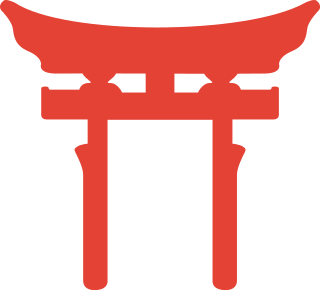
Shinto or kami-no-michi is the traditional religion of Japan that focuses on ritual practices to be carried out diligently to establish a connection between present-day Japan and its ancient past.

A Shinto shrine is a structure whose main purpose is to house ("enshrine") one or more kami. Its most important building is used for the safekeeping of sacred objects, and not for worship. Although only one word ("shrine") is used in English, in Japanese, Shinto shrines may carry any one of many different, non-equivalent names like gongen, -gū, jinja, jingū, mori, myōjin, -sha, taisha, ubusuna or yashiro.

Atsuta Shrine is a Shinto shrine traditionally believed to have been established during the reign of Emperor Keikō (71-130) located in Atsuta-ku, Nagoya, Aichi Prefecture in Japan. The shrine is familiarly known as Atsuta-Sama or simply as Miya. Since ancient times, it has been especially revered, ranking with the Grand Shrine of Ise.

Yasaka Shrine, once called Gion Shrine, is a Shinto shrine in the Gion District of Kyoto, Japan. Situated at the east end of Shijō-dōri, the shrine includes several buildings, including gates, a main hall and a stage.

The Gion Festival takes place annually in Kyoto and is one of the most famous festivals in Japan. It lasts for the entire month of July and culminates in a parade, the Yamaboko Junkō (山鉾巡行) on July 17 and July 24. It takes its name from the Gion district of the city.

Kamigamo Shrine is an important Shinto sanctuary on the banks of the Kamo River in north Kyoto, first founded in 678. Its formal name is the Kamo-wakeikazuchi Shrine.

Samukawa Shrine is a Shinto shrine in the town of Samukawa in Kanagawa Prefecture, Japan. This shrine is one of the most famous shrines around Tokyo, where about 2 million people visit each year.

Sanja Matsuri, or Sanja Festival, is one of the three great Shinto festivals in Tokyo. It is considered one of the wildest and largest. The festival is held in honor of Hinokuma Hamanari, Hinokuma Takenari, and Hajino Nakatomo, the three men who established and founded the Sensō-ji Buddhist temple. Sanja Matsuri is held on the third weekend of every May at Asakusa Shrine. Its prominent parades revolve around three mikoshi, as well as traditional music and dancing. Over the course of three days, the festival attracts 1.5 to 2 million locals and tourists every year.

The Hokkaidō Shrine is a Shinto shrine located in Sapporo, Hokkaido, Japan. Sited in Maruyama Park, Chūō-ku, Sapporo, Hokkaido, the Hokkaido Shrine enshrines four kami including the soul of the Emperor Meiji. A number of early explorers of Hokkaidō such as Mamiya Rinzō are also enshrined.

Yaizu Jinja (焼津神社) is a Shinto shrine in the city of Yaizu in Shizuoka Prefecture, Japan. The shrine is also referred to as the Irie Daimyojin (入江大明神).The main festival of the shrine is annually on August 13.

Kanda Matsuri (神田祭) or the Kanda Festival, is one of the three great Shinto festivals of Tokyo, along with the Fukagawa Matsuri and Sannō Matsuri. The festival started in the early 17th century as a celebration of Tokugawa Ieyasu's decisive victory at the battle of Sekigahara and was continued as a display of the prosperity of the Tokugawa shogunate during the Edo period. Additionally, the current form of the festival is also held in honor of the kami of Kanda Myōjin.

Kanda Shrine, is a Shinto shrine located in Chiyoda, Tokyo, Japan. The shrine dates back 1,270 years, but the current structure was rebuilt several times due to fire and earthquakes. It is situated in one of the most expensive estate areas of Tokyo. Kanda Shrine was an important shrine to both the warrior class and citizens of Japan, especially during the Edo period, when shōgun Tokugawa Ieyasu paid his respects at Kanda Shrine. Due in part to the proximity of the Kanda Shrine to Akihabara, the shrine has become a mecca for the technophiles who frequent Akihabara.

Kanjō (勧請) in Shinto terminology indicates a propagation process through which a kami, previously divided through a process called bunrei, is invited to another location and there reenshrined.

Usa Jingū (宇佐神宮), also known as Usa Hachimangū (宇佐八幡宮), is a Shinto shrine in the city of Usa in Ōita Prefecture in Japan. Emperor Ojin, who was deified as Hachiman-jin, is said to be enshrined in all the sites dedicated to him; and the first and earliest of these was at Usa in the early 8th century. The Usa Jingū has long been the recipient of Imperial patronage; and its prestige is considered second only to that of Ise.

Mikoshi-nyūdō is a type of bald-headed yōkai "goblin" with an ever-extending neck. In Japanese folklore and Edo period (1603–1868) kaidan "ghost story" texts, mikoshi-nyūdō will frighten people who look over the top of things such as byōbu folding screens. The name combines mikoshi 見越し "looking over the top ; anticipation; expectation" and nyūdō 入道 "a (Buddhist) priest; a bonze; a tonsured monster".

This is the glossary of Shinto, including major terms the casual reader might find useful in understanding articles on the subject. Words followed by an asterisk (*) are illustrated by an image in one of the photo galleries. Within definitions, words set in boldface are defined elsewhere in the glossary.

In Shinto, shintai, or go-shintai when the honorific prefix go- is used, are physical objects worshipped at or near Shinto shrines as repositories in which spirits or kami reside. Shintai used in Shrine Shinto can be also called mitamashiro.

Kasai shrine was the head shrine of eleven towns in the region and is classified historically as a "Gousha". It is located in Higashi Kanamachi, Katsushika district, Tokyo.



















